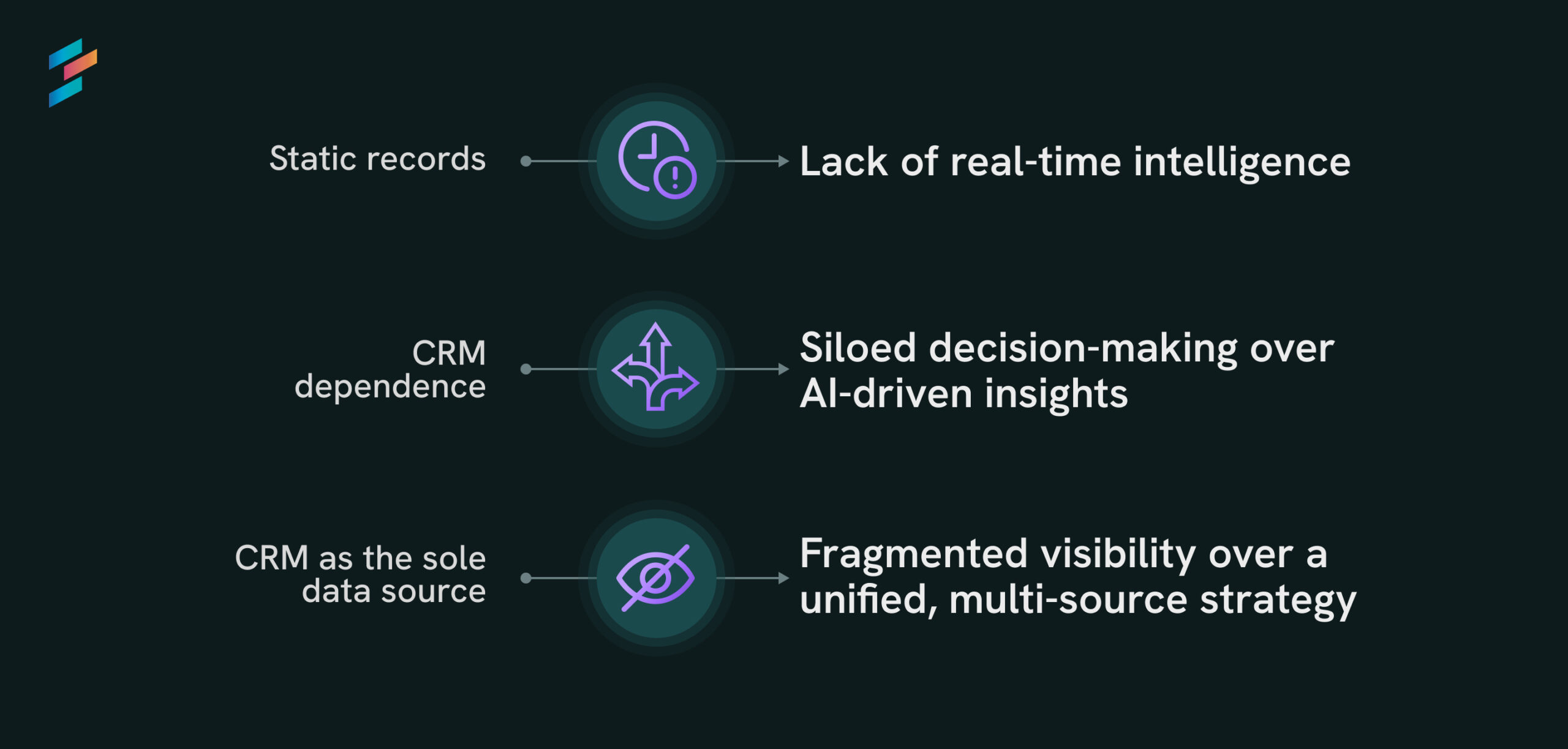For years, Key Account Management (KAM) has been confined within the walls of CRM systems—Salesforce, Microsoft Dynamics, and HubSpot. The logic was straightforward: if customer data already lives inside a CRM, why manage key accounts elsewhere?
But this assumption, simple as it is, hides a fundamental flaw.
CRMs are systems of record. They track transactions, monitor pipelines, and organize data. But Key Account Management is more than just structured data—it requires real-time insights from multiple sources. Conversations, stakeholder engagement, external market intelligence, and predictive signals all play a crucial role in shaping long-term growth.
And there lies the friction.
Key Account Management is not an extension of sales. It is a strategic function—an intelligence-driven discipline designed to uncover expansion, deepen relationships, and orchestrate long-term growth.
A CRM is a tool. KAM is a strategy—one that must be dynamic, predictive, and cross-functional. Yet, for years, organizations have tried to force this environment into a rigid, transaction-focused system.
The result?
- Account teams are left blind to expansion opportunities because their CRM does not integrate third-party intelligence tools like Gong, Chorus, and Outreach.
- Growth potential is capped by the inability to connect insights across multiple tools you use every day like CRMs, sales, and business intel tools.
- A systemic misunderstanding of what it takes to nurture and protect high-value accounts.
Companies relying solely on CRM-native KAM tools experience a 37% lower revenue retention from key accounts than those using dedicated KAM platforms.
CRM-native KAM is okay if you have very few accounts in the bag and are content with them. But if you want to grow your KAM program, expand your revenue, and build long-term relationships, CRM-based KAM is a recipe for disaster.
The shift is imperative if you are serious about your KAM program. Read on to know why.
The Silent Constraints of CRM-Native KAM
A key account manager logs into their CRM, and prepares a quarterly business review. The system greets them with neatly arranged data—deal histories, revenue forecasts, and contact logs.
But something is missing.
- Where are the external market forces shaping the account’s trajectory?
- Where are the unstructured insights—the informal conversations, strategic signals, and competitive shifts that influence decision-making?
- Where is the predictive analysis on expansion opportunities (white spaces), powered by AI?
- Who are the contacts (Relationship Intelligence) that remain unengaged, and have you engaged with the right stakeholders enough?
- Who are the true economic decision-makers driving strategic purchasing decisions?
- Where are the whitespace opportunities that could unlock additional growth?
- And how are you faring with the opportunities you’ve already identified—are they progressing, stalling, or at risk? More importantly, how well are you adhering to your sales methodology? Whether following MEDDIC, SPIN, or Challenger, the effectiveness of a KAM program depends on structured execution.
The CRM does not provide these answers. And the key account manager cannot blame it because it was never built to provide those answers.
Expanding key accounts requires intelligence beyond what is stored in structured records—insights from stakeholder conversations, buying intent signals from email interactions, and competitive shifts impacting strategic decisions.
For companies managing high-value, multi-region, multi-business-unit accounts, the constraints of CRM-native KAM are no longer just inconvenient. They are actively eroding revenue potential.
1. The Invisible Revenue Ceiling: How CRM Limits Growth
Key accounts do not exist in isolation. They span subsidiaries, cross geographies, and integrate into broader ecosystems. They interact with partners, competitors, and regulators—forces that exist outside the walls of any single CRM.
Yet CRM-native KAM assumes that all relevant data is internal. All decision-makers reside within the same CRM instance.
This assumption creates a ceiling on revenue growth.
Account expansion is a self-contained strategic process. It depends on data, but that data needs to have an intelligence layer to make the most of it.
Without multi-tool visibility, organizations lose track of data, decision-making becomes vulnerable, and expansion opportunities are compromised. Regional subsidiaries remain disconnected, and strategic white spaces remain unseen.
A company may think they are managing a key account effectively—when in reality, they are operating within a fraction of its total potential.
2. The One-Door Problem: A Narrow, Internalized View of the Market
Yet, CRM-native KAM assumes that key account intelligence is a closed-loop system—one that begins and ends with internal sales data.
The reality is far more complex.
Key account growth is driven by external forces:
- Market shifts that redefine customer needs.
- Partnership networks that dictate purchasing decisions.
- Competitive moves that threaten existing relationships.
A CRM, by design, cannot incorporate these signals.
3. Competitive Innovation: The Market’s Verdict on CRM-Native KAM
As CRMs introduce KAM-related features, it signals a growing recognition that managing key accounts requires more than structured sales data.
The real shift, however, is happening outside CRM systems—where AI-driven platforms are integrating data from multiple tools, uncovering white space opportunities, and providing real-time strategic insights.
Today, AI-Driven KAM Platforms Provide:
- Multi-Tool Integration – Offering a unified, real-time view of key accounts across not just CRMs (Salesforce, HubSpot, Microsoft Dynamics) but also customer success platforms, business intelligence tools, contract management systems, and external data sources. This ensures cross-functional intelligence rather than CRM-dependent visibility.
- AI-Powered Opportunity & Risk Intelligence – Beyond traditional expansion modeling, AI-driven KAM platforms use multiple AI agents—resource agents to surface white space, risk agents to detect early churn signals, and intelligence engines to identify at-risk contacts. In the future, these platforms will even build proactive account plans.
- Proactive Insight Generation – Instead of just aggregating static CRM data, AI-powered KAM platforms analyze fast-moving trends across 30+ enterprise tools, generating crisscrossed insights that would otherwise go unnoticed. This eliminates the “you don’t know what you don’t know” problem—alerting teams to strategic moves they might have missed.
- Market-Aware Intelligence – Capturing external signals such as competitive threats, partnership shifts, regulatory changes, and customer sentiment analysis—not as an isolated feature, but as part of a continuously evolving AI-driven ecosystem.
The difference? While CRMs are evolving, even if they integrate some external data, they remain systems of record. AI-powered KAM platforms, on the other hand, are built for dynamic, predictive, and proactive growth—moving beyond CRM’s static nature to actively drive account expansion.
The Market Shift: Why This Is Happening Now
For decades, Key Account Management was treated as an extension of sales. A function that followed sales motions, lived in sales tools, and was measured by sales metrics.
But the past decade has fundamentally changed KAM’s role.
- KAM has always been a core revenue discipline. Organizations with structured KAM strategies report 50% higher customer lifetime value (CLV) and 31% lower churn among key accounts.
- Enterprise organizations now operate across multiple CRM environments.
- 68% of large enterprises manage accounts across multiple CRMs.
- 42% of B2B companies say their largest deals require coordination across multiple CRMs.
- AI and predictive KAM intelligence are transforming account growth.
- Companies using CRM-agnostic KAM platforms see a 27% increase in deal velocity.
Can you observe the structural shift happening here?
The organizations that recognize it will redefine competitive advantage. The ones that hesitate will be left behind.
Breaking Free: The Case for CRM-Agnostic KAM
To break free from CRM limitations is not to abandon structure. It is to redefine it.
CRM-native KAM assumes that structured data and internal sales metrics are enough to drive account expansion. But real-world key account growth depends on intelligence that exists outside the CRM—in customer conversations, market shifts, competitive threats, and stakeholder engagement trends. AI-powered, CRM-agnostic KAM platforms are solving this by integrating multiple data sources and applying predictive intelligence.
Here’s how AI is unlocking a new era of Key Account Management:
1. A Unified, Multi-CRM Ecosystem
Traditional CRM-native KAM traps data within sales records, deal histories, and contact logs. But key accounts span subsidiaries, industries, and global markets—operating across multiple business units and regulatory landscapes.
A dedicated KAM platform unifies account data across multiple CRMs, business intelligence tools, customer success platforms, and contract management solutions. Instead of operating in silos, AI-driven KAM solutions create a single source of strategic truth, ensuring seamless intelligence-sharing across functions.
- AI-powered KAM platforms scan contract data, purchase histories, and engagement trends to detect expansion opportunities before account managers see them.
- A resource AI agent automatically flags accounts with increased engagement in specific product categories, alerting teams to cross-sell and upsell possibilities.
AI eliminates blind spots and unlocks hidden revenue streams that static CRM data alone would never reveal by integrating insights from 30+ tools,
2. AI-Powered Expansion & Relationship Intelligence
CRM-native KAM relies on manually updated records that fail to track how decision-makers and influencers shift within an organization. Key accounts, however, are dynamic ecosystems—where stakeholders change, new players emerge, and relationships evolve over time.
AI-driven KAM platforms go beyond structured data, leveraging natural language processing (NLP), sentiment analysis, and entity recognition to track stakeholder movements, engagement levels, and organizational influence in real-time.
- AI analyzes email sentiment, call transcripts, and meeting notes (via tools like Gong, Chorus, Outreach) to identify at-risk or disengaged contacts before churn risks escalate.
- AI maps influencers, decision-makers, and hidden stakeholders, ensuring account managers engage the right people at the right time.
3. Predictive Risk & Churn Detection
CRM-based KAM tracks renewals but lacks predictive intelligence to detect warning signs early. By the time an account is flagged as at-risk, the damage is already done.
AI-powered KAM platforms correlate behavioral patterns, support ticket volumes, and engagement drop-offs to detect churn risks before they escalate.
- AI detects a 25% decline in executive engagement over three months, combined with increased support tickets and delayed procurement responses.
- A risk AI agent automatically alerts the account team, suggesting proactive retention strategies before renewal discussions even begin.
4. Market Intelligence & Competitive Awareness
KAM does not operate in isolation. Competitive movements, industry disruptions, and regulatory shifts directly impact strategic accounts. Yet, CRM-native KAM solutions fail to capture these external forces, leaving account teams unaware of market-driven threats and opportunities.
AI-powered KAM platforms continuously ingest real-time external data—including competitor pricing shifts, partnership announcements, and regulatory updates—and correlate them with key account strategies.
- AI tracks competitor moves, industry shifts, and sentiment analysis across news, analyst reports, and partnership changes.
- AI flags accounts where competitive pressure is rising, allowing KAM teams to engage proactively instead of losing ground to rivals.
The difference? CRM-native KAM only looks inward, while AI-driven KAM operates with a 360-degree market-aware approach.
5. Future-Proofing Growth
The next five years will reshape Key Account Management. Organizations that fail to integrate AI-driven KAM strategies will struggle to compete with those that already operate beyond CRM-centric models.
The shift is happening now:
- 68% of large enterprises manage accounts across multiple CRMs.
- 42% of B2B companies say their largest deals require multi-CRM coordination.
- AI-powered KAM platforms drive a 27% increase in deal velocity.
Without AI-driven intelligence, organizations will be stuck in reactive, transaction-focused account management—while their competitors leverage AI for strategic, revenue-expanding KAM.
The Road Ahead
Every company faces a moment where its tools become its constraints.
In Key Account Management, that moment has arrived as key account managers have started seeing the shortcomings of CRM-native KAM programs.

Do you see the difference?
The time is now to act—by expanding beyond CRM-centric KAM models and embracing AI-driven platforms that integrate conversations, relationship intelligence, and external market signals to drive strategic growth.
So, are you ready to break free?



